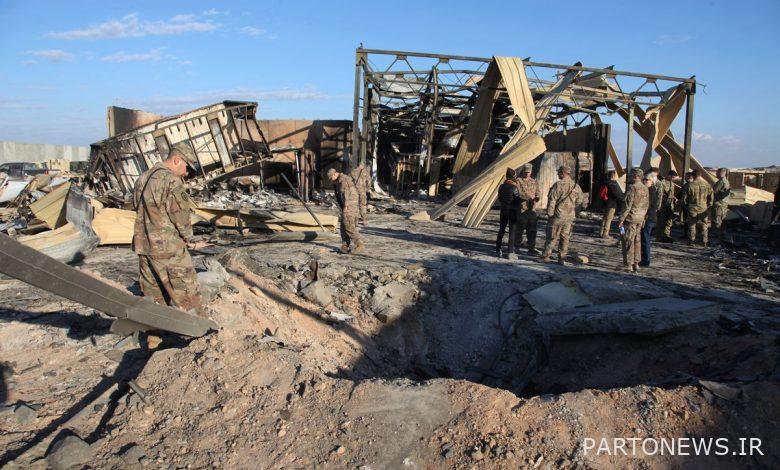From concealment to acknowledgment; Washington’s secret retelling of ‘Ain al-Assad’ hell

According to IRNA, General Qassem Soleimani, commander of the Quds Force, and Abu Mehdi al-Mohandes, deputy commander of the Iraqi People’s Forces Organization, along with eight of their aides, headed to Baghdad airport on Friday morning, January 4, at the behest of US President Donald Trump and Pentagon drones. ) Were assassinated and martyred.
In the first step of revenge for this terrorist operation, the Islamic Revolutionary Guard Corps fired “dozens” of ballistic missiles at the US base of Ain al-Assad in the Iraqi province of Anbar at 1:20 AM on January 9th.
In a part of the IRGC public relations announcement, it was stated: The brave fighters of the IRGC Air Force during a successful operation called Operation Shahid Soleimani, with the holy code or Zahra (PBUH) fired dozens of surface-to-surface missiles, the occupied air base of the terrorist and aggressor US Army They crushed the so-called Ain al-Assad.
The Ain al-Assad military base, known as Saddam Hussein al-Qadisiyah’s dictatorship, is Iraq’s second largest air base, located 108 km west of Ramadi, and was occupied by US forces in 2003 and held until 2011. At the end of 2014, with the intention of “fighting ISIS”, the base was once again given to the US military in the International Anti-ISIS Coalition.
Washington fringe, media skepticism
Hours after Iran’s missile revenge, US President Donald Trump tweeted: “Missiles have been fired from Iran at two military bases in Iraq.” An assessment of casualties is currently underway. So far so good! We have the most powerful and well-equipped army in the whole world! I will issue a statement tomorrow morning.
Contradictory news about the amount of damage and casualties to the American troops stationed at this base was published from the very first hours of the rocket fire.
Hours after the rocket fire, an Iraqi official announced that nine Iranian ballistic missiles had been fired at the Ain al-Assad air base in the western province of Anbar. He added that there was no immediate word on casualties or damage from the missile strike.
Some sources also reported that the attack left at least 80 dead and 25 wounded.
Three days after the rocket fire, the American news network CNN published the first video images in closed frames of the consequences of the attack on the Ayn al-Assad base.
The network’s correspondent, Arwa Damon, filmed a documentary on the devastation caused by Iranian missiles in the ruins of what was once a well-equipped US military base.
He said in his report that almost nothing was left of the base and it was very strange that no one was injured in such a ruin. Apparently, hours before the attack, an initial warning was given and the forces were aware in advance that something might happen. At around 11pm, American soldiers began to take refuge in underground shelters. At around one o’clock in the morning, the first rocket hit.
Buy time; Drip information
In the very first days after Iran’s reaction, the Washington Post quoted a military official at the Ain al-Assad base as saying that at least two American soldiers had been thrown out of the window of a watchtower and dozens more had been killed. They are gone.
Gradually, with the policy of “dripping information”, US officials tried to reveal the hidden facts of these attacks little by little. In this regard, the US-led international coalition against ISIL acknowledged on January 17 that 11 US troops had been injured in the Iranian missile strike.
The coalition said in a statement that while no troops were killed in the Iranian attack on Ayn al-Assad, “several soldiers” were being examined and treated for signs of brain damage from the blast.

The announcement was met with a response from the Pentagon, forcing Pentagon officials to step down. Pentagon spokesman Bill Urban acknowledged on January 17 that 11 US troops stationed at the Ain al-Assad base had suffered brain damage after an Iranian missile strike.
“Contrary to the Pentagon’s previous announcement, several military personnel at the Ein al-Assad base were injured during a January 8 (December 18) missile strike in Iran,” Cyanan wrote on its news website a few days later.
Recalling that the United States had “erred” in its initial estimates following the missile strikes, the media wrote: “The damage to US troops stationed at the base is more serious than the Pentagon’s initial estimates.”
The Pentagon initially said there were no casualties following the firing of 16 missiles by Iran, but US military officials told the network that 11 US troops had been wounded.
As the number of casualties from Ain al-Assad’s missile strikes increased in the media and statements by US officials, Danish television on January 28 spoke to a Danish officer in the Ayn al-Assad base about revenge for Iran’s missiles. The interview also showed that the US military is making a serious effort to conceal the facts of its casualties. Danish forces, along with other European forces, retreated directly to Kuwait a day after the Iranian invasion.
Acknowledging the accuracy of IRGC missiles
He went on to say that the missiles did not sound before the first missile was fired. The missiles were very accurate and aimed at their intended targets with great accuracy; Without a single missile falling or deviating from its target. From this it can be seen that the Iranians had detailed plans of bases, headquarters, shelters and aircraft hangars, and they could calm down these facilities at the peak.
About a month later, the website of the American Institute for Strategic and International Studies (CSIS) wrote in an article on the aftermath of Iran’s missile strikes that newer information indicates that the attacks had far-reaching consequences. For example, a review of available evidence suggests that initial assessments that Iran did not intend to harm US forces in the attack were inaccurate.
The report goes on to say: “These attacks also show that Iran’s ballistic missile force, in terms of technology and operational capability, has the potential to inflict major damage on the United States and allied military operations in the Middle East;” Finally, these attacks show that Iran bears a strategic risk and is less deterred from threatening US military action. This new situation may require the United States to reconsider the status of its forces in the region.
“The missiles hit within ten meters of their targets,” said Gen. Frank Mackenzie, commander of US Central Command (Centcom), in an interview with Time magazine. What the Iranians have done in the last three to five years is to build a very powerful ballistic missile platform. He acknowledged that Iran had demonstrated that its missiles had a proven ability to strike precisely at targets.
Congress criticizes Trump and the Pentagon
The insignificance of Iran’s attacks on US military bases was so furious that Democratic Sen. Chris Murphy slammed then-President Donald Trump for downplaying US military casualties. “No one will be sent to Germany for a headache,” Murphy told Trump in an interview with CBS News. Troops are flown to Germany when they are badly injured.
Following the criticism, Pentagon spokesman Jonathan Hoffman confirmed at a news conference that 34 U.S. servicemen had suffered “brain injuries” during an Iranian missile strike on the Ain al-Assad military base in Iraq. And some have been transferred out of Iraq.
On February 30, Thomas Campbell, another spokesman for the US Department of Defense, was tasked with announcing an increase in the number of American casualties, and he said in a statement: To date, brain damage has been diagnosed in 50 US troops. He added that of those 50, 32 had been treated in Iraq and returned to their mission, and another 18 had been transferred to Germany for further examination and treatment.
The US government’s censorship of information about the casualties of the missile strike on Ayn al-Assad appeared to be aimed at reducing the impact of the shock. The US government either had to declare real casualties and be pressured to respond to the attack, or falsify the facts so as not to have to respond militarily to Iran’s response.

Such a media policy provoked criticism from members of the US Congress again, and two members of the House of Representatives wrote a letter to the US Secretary of Defense criticizing the disclosure of contradictory statistics on the number of US troops injured in the Iranian missile strike on Ain al-Assad base.
Reviewing the process of announcing the casualties of the Ayn al-Assad rocket attack, we find that US President Donald Trump, who directly ordered the assassination of Sardar Soleimani, initially stated that no American forces were injured in the missile attack; But after that, the Pentagon announced in several stages that 11, 34, 50 and in the latest statistics, 64 American troops present at the Ein al-Assad base were treated for brain damage.
The envoys also asked the Pentagon’s inspector general to determine whether an attempt had been made to downplay the casualties of the Iranian missile strike and how resistant the shelters at US bases were to the blast.
Meanwhile, Reuters quoted U.S. officials as saying that more than 100 people had suffered brain damage from Iran’s missile strike on the Ain al-Assad base.
Reuters quoted an unnamed US official as saying that more than 100 US troops had suffered brain damage in an Iranian missile strike on the Ain al-Assad base. Pentagon officials, who initially denied the casualties, again changed the number of casualties, eventually announcing that 110 U.S. soldiers had suffered brain damage during the shelling.
Soldiers’ memories of that horrible night
Months later, as the consequences of Iran’s vindictive retaliation against US forces in Iraq subsided, a Washington Post reporter approached the troops present at the time of the Iranian missile strike and revealed new dimensions of American panic and anxiety.
Alan Johnson of the U.S. military in Ain al-Assad has struggled to concentrate after being hit by a blast, including a missile blast that struck about 18 meters from his hideout, the Washington Post reported.
“I’m still anxious,” he said. I still have nightmares; The nightmare of the sound of approaching missiles.

“I do not think there was anyone who survived that night without any trauma, whether psychological or emotional,” said another U.S. soldier, Jonathan Jordan.
Survivors of the attack believe that what happened to them was ignored due to events such as the corona outbreak and internal debates over the US presidential election.
“Another U.S. soldier and his comrades-in-arms, Brian Modi, boarded an anti-personnel truck before the rockets hit to keep them safe,” the report said. Several forces were also stationed at the watchtowers to prepare for a ground attack. Almost all the other forces had taken refuge at the base.
The first missile exploded at about 1:54 a.m. local time, about 91.5 meters from an anti-personnel truck, and debris fell on it. The next rocket exploded, knocking on the truck doors.
Johnson does not remember the first three blasts, saying it was because the third blast knocked him and other American soldiers unconscious and knocked them to the ground. The third missile landed about 64 meters away.
Surviving soldiers hesitated to leave the shelter even after hearing the message that the danger was over. “Some were crying, some were moaning and some were vomiting,” Johnson said.
Davenport and Modi said they were not injured, but wondered how the United States got over it so quickly. “Sometimes it breaks a person’s heart,” Davenport said. Some people do not even know it happened.
Gen. Frank Mackenzie, the top commander of US forces in the Middle East, told CBS News more than a year after the missile strike on the US base in Iraq: “If the base had not been evacuated, there could have been 20 to 30 planes and 150 US troops in the area.” Lose that attack.
CBS News reported that Mackenzie had enough time to evacuate the 1,000-strong force and 50 aircraft when the US intelligence service identified Iran’s readiness for the missile strike.
The American commander added: “Certainly I have not seen or experienced such an attack.” Their missiles are accurate. They hit almost where they wanted to hit.
Covering up the reality of the attack on Ayn al-Assad did not last long, and a month ago the USA Today website reported that it had obtained a report showing that Iran’s missile operation and its aftermath had been largely kept secret from the public until last month. Commanders were not allowed to request a purple heart badge for their wounded soldiers, which is awarded in honor of soldiers wounded in battle.
.

